From idea to impact: how to set up your nonprofit .org website with Hostinger

You may already know that a website is a powerful tool for nonprofit organizations to spread their message and rally support. But did you know that a .org domain name can take you even further?
Whether you’re starting a charity, advocacy group, or community project, this article will walk you through building a unique and professional website to support your mission. We’ll cover everything from the benefits of a .org domain to tips on optimizing your website for success.
Why a .org domain matters for your nonprofit
Short for “organization,” the .org domain name extension (or top-level domain) is popular among mission-driven groups. People associate it with nonprofits or charities, so using one signals that your website is for a cause rather than for profit.
Besides building trust and credibility, a .org domain can improve your website’s visibility on search engines. When users search for nonprofit-related content, your site will have a better chance of appearing. More traffic means more people will become aware of your mission.
As a web hosting provider that doubles as a domain name registrar, Hostinger makes it easy to register your .org domain. We help you find available .org domain names, register your pick, and link it to your hosting account with just a few clicks.
Let’s break it down step by step, starting with the domain registration process.
Pro tip
Learn the differences between domains vs hosting to get the most out of both.
Finding and registering your perfect .org domain with Hostinger
Choosing the right domain name is an important step for your nonprofit website. It will be your website’s online address, so don’t settle for just any name.
Start by brainstorming simple, memorable names that relate to your cause. Think about what your organization stands for and try to make the name short and easy to spell.
Words like “help,” “charity,” or “community” can make your custom domain name more meaningful and easier to remember. Alternatively, using your organization’s name or abbreviation helps maintain brand recognition.
Here are some domain examples from popular nonprofits for inspiration:
- Habitat for Humanity ‒ habitat.org
- Doctors Without Borders – doctorswithoutborders.org
- Room to Read – roomtoread.org
- Smile Foundation ‒ smilefoundationindia.org
- International Society for Human Rights ‒ ishr.org
Struggling to come up with a good website name? Try Hostinger’s AI-powered domain checker tool.
Simply describe your project’s mission and include key details like the TLD and any important keywords you want to use. The tool will suggest available domain options for you.
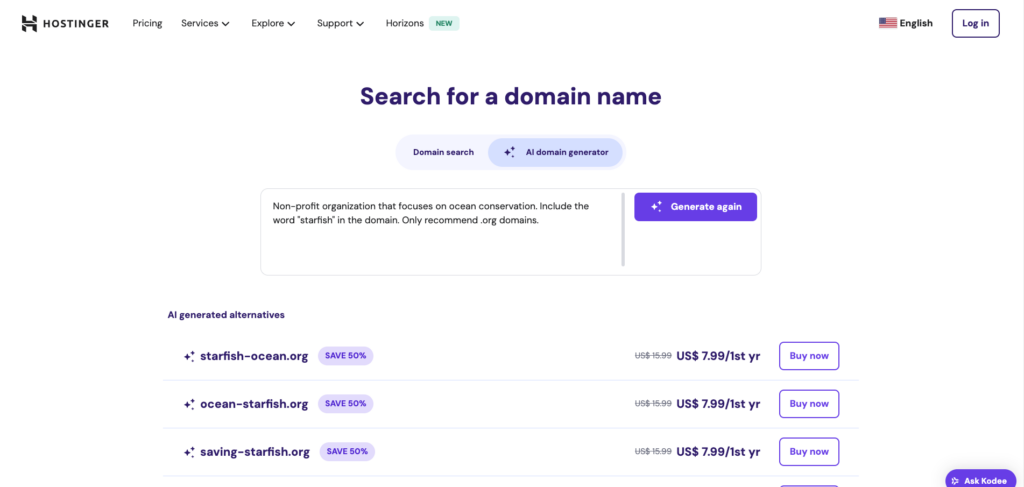
Domain Name Checker
Instantly check domain name availability.
After finding the most suitable domain name, complete the purchase process. Choose a registration period that fits your needs and budget. The minimum period is one year, but you can register for multiple years to save money in the long run.
Certain domain registrars may offer additional services to purchase with your domain. At Hostinger, you can buy an annual hosting plan and get your domain registration free for the first year.

Other important options to consider include domain privacy protection ‒ which hides your contact information from public registries to prevent spam and protect your privacy ‒ and email hosting.
When you register a domain, you’ll usually need to provide basic information like your name, address, email, and phone number. This information is publicly available in the RDAP (formerly WHOIS) record, unless you enable domain privacy protection.
A new domain name is usually active within a few hours, but it can take up to 24-48 hours for DNS settings to fully update across the web.
Then, connect the domain to your website. If you host with Hostinger, this process is part of the website setup, making it super easy. Otherwise, check out our guide to pointing your domain to a different hosting provider.
Pro tip
Enable automatic domain renewal to avoid the risk of downtime, which could hurt your organization’s credibility and reputation.
Building your nonprofit’s online presence
Getting started with a website builder
There are several ways to build your own website, but using a website builder is the easiest option, especially if you’re not a developer.
With drag-and-drop functionality, ready-made templates, and simple customization options, you can build a unique, professional website without coding. Just buy a subscription plan that fits your needs and budget, and you’re good to go.
With so many options, keep these factors in mind when choosing a website builder:
- Ease of use. Choose a builder that you or your team can easily work with. It should simplify the job of making a website so that you can do it without hiring an expert.
- Customization. The ideal builder should offer a suitable template that enhances your message and looks good on all devices. Being able to add your own branding is also crucial.
- Features. Make sure the builder has necessary functions like contact forms for newsletters or ecommerce tools for accepting donations.
- Security. Look for security measures like SSL certificates, malware protection, and GDPR compliance to ensure your website is safe for visitors to interact with.
- Support. Confirm that help is easy to access through live chat, tutorials, or other channels.
- Pricing. Compare prices to find a plan that fits your budget and provides the features you need.
Hostinger’s website builder checks all the boxes. Starting at $2.99/month, all plans include a drag-and-drop editor with a smart grid, 24/7 customer support, and AI tools to simplify the site-building process. Plus, you’ll get a free one-year domain registration with any annual subscription.
If you plan to accept donations online, the Business plan at $3.99/month might be a better fit. It includes AI tools to create visuals, logos, copy, and more to help your site stand out.
Essential pages for your nonprofit website
Once you’ve decided how to build your .org website, the next step is choosing the content to include.
While there’s no set rule for how many pages your website should have, each page should have a clear, singular purpose to avoid clutter or confusion. Most importantly, the site should be structured logically so visitors can easily navigate through it to find what they are looking for.
Here are suggestions for key pages to educate, engage, and convert visitors into donors or volunteers:
- Homepage. This is the first page visitors see on your website, so it should clearly communicate who you are, what you do, and how they can get involved. Add calls to action (CTA) to encourage learning more, donating, or volunteering.
- About us. Share your project’s mission, history, values, and goals. This page helps visitors understand your nonprofit’s purpose and builds trust by showing your credibility and impact.
- Donation or volunteer page. This is where visitors can take action by donating money, goods, or time. Make it easy to donate or sign up for volunteer opportunities, and provide clear instructions to show how they can support your cause.
- Contact us. A vital page that allows visitors to reach out to you with questions or inquiries. Add a contact form alongside an email address, a phone number, and social media links for easy communication.
- Programs or services page. Highlight key programs or services provided by your nonprofit. This page helps visitors understand the work you do and how you’re making an impact.
- Blog or news. Keep your supporters updated with recent news, events, or success stories related to your mission. A blog can also boost SEO and engagement ‒ more on this later.
- Partners or sponsors page. If you have partners, sponsors, or supporters, list them here. This builds credibility and highlights the network that supports your organization.
- Privacy Policy. Show visitors how you handle their data and ensure compliance with privacy laws, such as GDPR.
Inspiring nonprofit website examples
Looking for inspiration? Let’s look at a few standout nonprofit websites that effectively communicate their missions and engage visitors.
Pratham
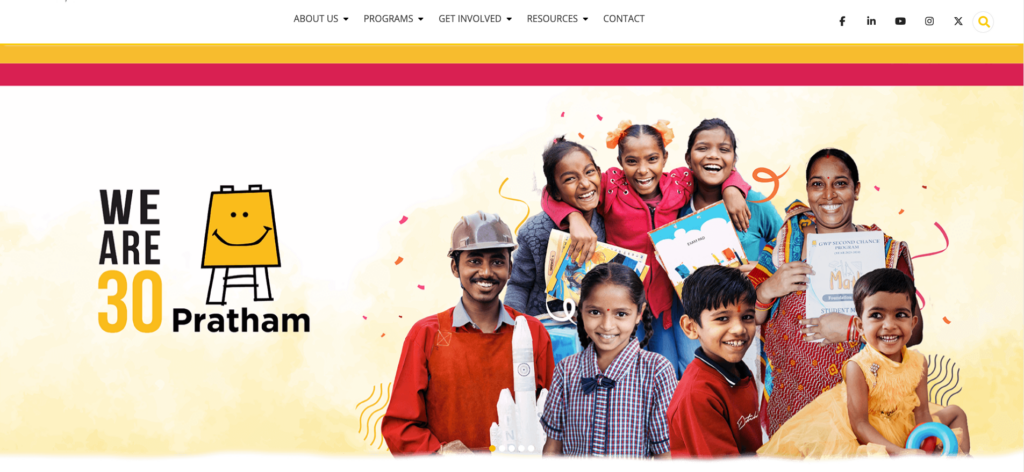
Pratham builds credibility right away with a pop-up that thanks visitors for supporting 30 years of improving education for children across India. The clever use of a pop-up, usually associated with ads, guarantees that new visitors see important information immediately.
Even with over 20 pages, dropdown menus ensure navigation is smooth. The homepage features high-quality visuals and clear CTAs in a hero slider, making key information easy to find.
Displaying statistics and success stories on the homepage helps inform visitors. Paired with plenty of white space and images of the children they help, the website effectively communicates Pratham’s mission and impact.
The Nature Conservancy
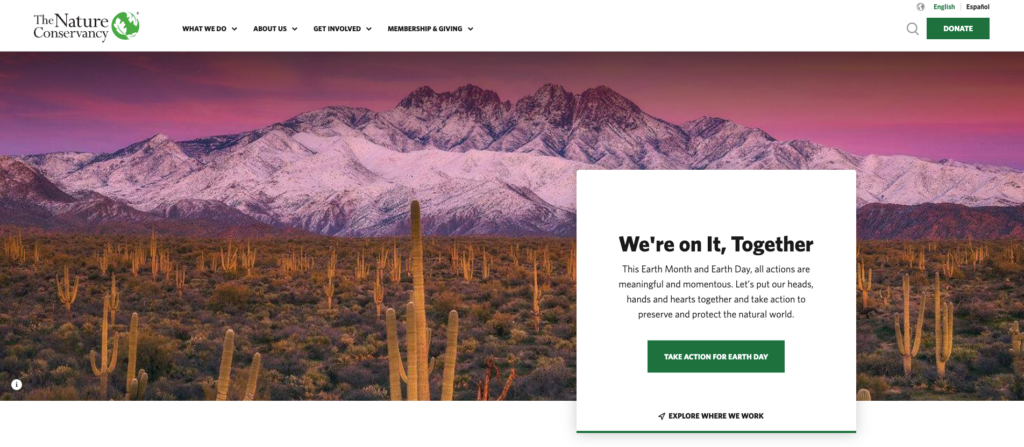
Unlike Pratham, this US-based environmental organization focuses on encouraging donations for its conservation efforts. The website features a donation button in a sticky header, so it remains visible as visitors scroll through the pages.
A pop-up asks visitors to subscribe to the Nature Conservancy newsletter, and social sharing icons below the pages make it easy to spread the word. The site also includes a language switcher, allowing visitors to view the content in English or Spanish.
Cancer Research UK
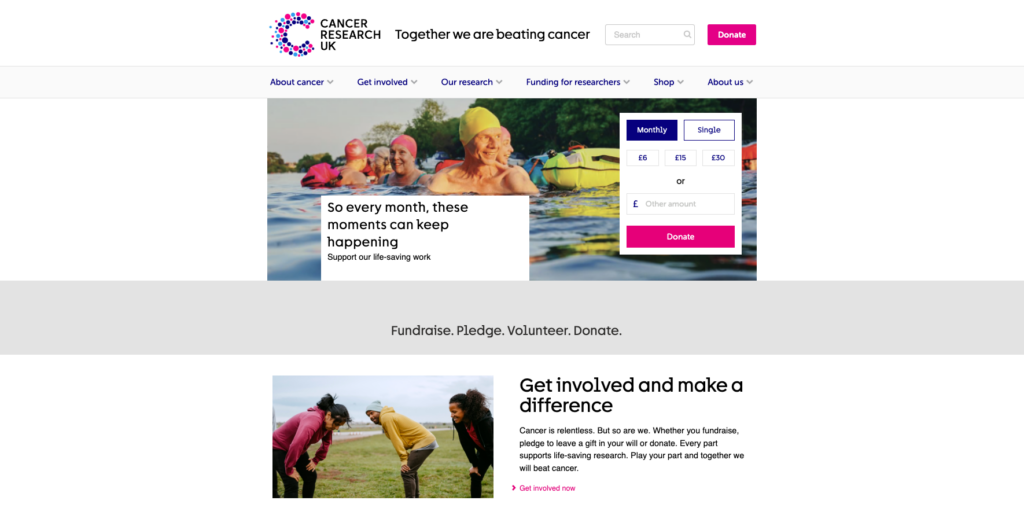
Focusing on funding cancer research, Cancer Research UK prominently displays its donation form on the homepage. This strategic positioning reduces the number of clicks needed to donate.
The website, which is text-heavy, uses bright-colored buttons and links to stand out. The color scheme aligns with the organization’s logo, grabbing attention and leaving a lasting impression.
Additionally, the site has an online charity store where visitors can buy second-hand items, flowers, and gifts to support research.
Customizing your website for maximum impact
A great nonprofit website should be beautiful and purposeful. The three websites we covered earlier are great examples. Let’s recap the key elements that make them stand out.
Compelling visuals and multimedia are essential for telling your story. Use high-quality images and videos that showcase the work you do and the people you help. These elements create an emotional connection, motivating visitors to take action.

Social sharing buttons help strengthen your online presence. You can also encourage visitors to sign up for your newsletter to receive regular updates. Both options make it easy for visitors to follow your mission, and share it with their networks.
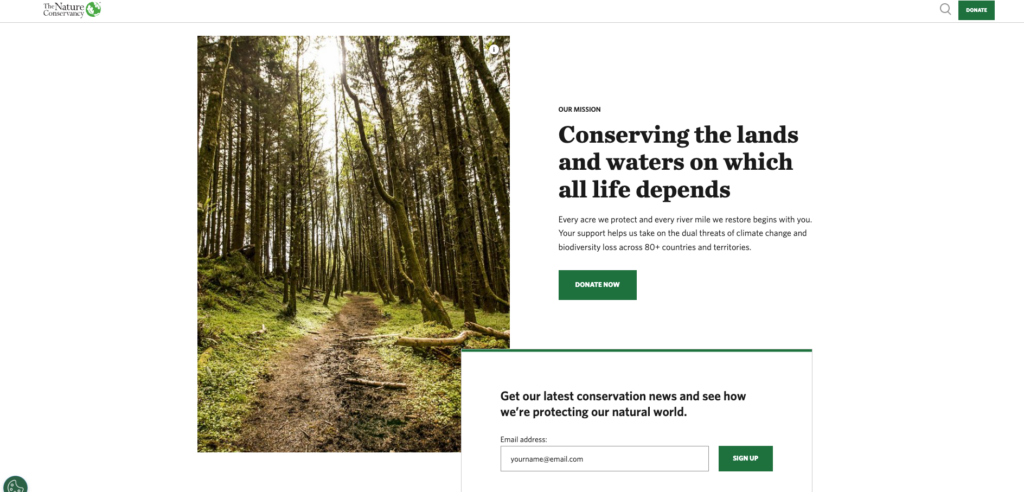
Payment processing features are essential if you plan to accept donations on your site. Highlight impact stories throughout your website to show how donations make a difference and inspire visitors to support your cause.
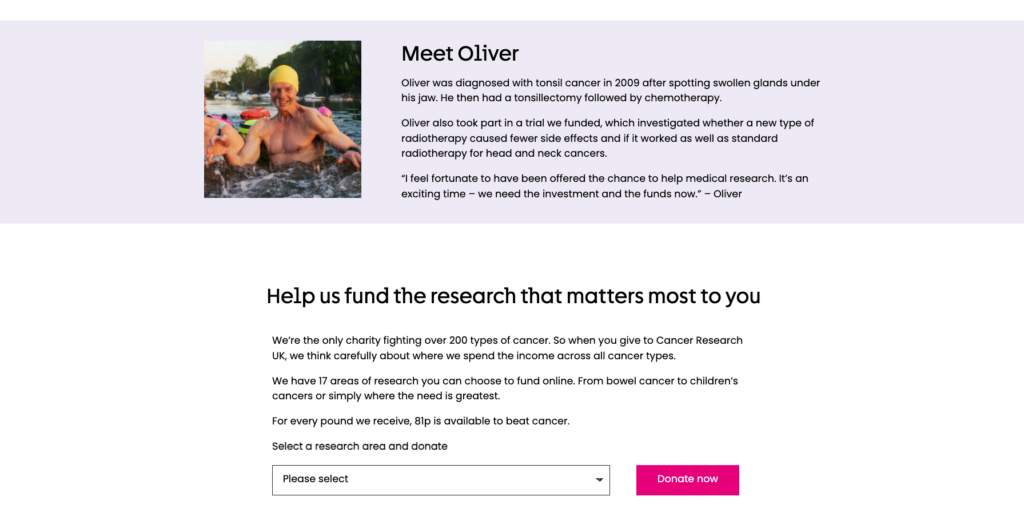
Adding fundraising features is also important for encouraging donations. Make it easy for visitors to give by adding clear donation buttons on your pages. You can also connect with crowdfunding platforms to raise money for specific projects or goals. Some of the most popular options include GoFundMe, Indiegogo, and Mightycause.
Most importantly, CTAs should be clear, guiding your visitors to take the next step ‒ donating, volunteering, or signing up for your newsletter. Use strong, action-oriented language like “Join Us,” “Donate Now,” or “Support the Cause” to inspire immediate action.
Need help with the above technicalities? Check out our beginner-friendly guide to building a website, complete with step-by-step instructions and helpful tips.
Optimizing your .org website for success
Launching a nonprofit website is only half the battle. To start attracting traffic, you need to make it appealing to the bots that search engines use to index websites. This process is called search engine optimization (SEO).
Many website builders make this easier with built-in features and SEO tools. For example, mobile-friendly templates can help you appeal to search engines’ mobile-first indexing. Automatic software updates keep your site safe for visitors. Some builders even let you customize meta titles and descriptions ‒ which show up in search results ‒ for better indexing and attracting potential visitors.
Here are a few basic SEO practices you can apply to improve your site’s performance further:
- Create quality content. This includes updating your website regularly with new content, like blog posts and success stories. Doing so will keep your site visitors engaged and will show search engines your site is active.
- Include relevant keywords in your website content. Consider what people might search for, such as “nonprofit donations” or “support environmental causes.” Avoid keyword stuffing ‒ only use them naturally in your content.
- Add alt text to images. This text describes images for search engines and makes your site more accessible to people using screen readers, as well as more user-friendly overall.
- Use internal links. For example, if you mention one of your major programs on your homepage, link to your site’s detailed page for that program. These links help search engines interpret your website structure and the primary topics on your site.
For better results, pair these SEO efforts with nonprofit marketing strategies. While SEO helps improve your website’s visibility, combining it with targeted marketing efforts like social media campaigns and video marketing can bring even more visitors.
Our nonprofit marketing tutorial covers everything about this topic, from its benefits to creating an effective marketing plan.
Most importantly, be sure to track your website’s performance. You can use these insights to improve your current strategies, identify bottlenecks, and better understand your target audience.
Hostinger Website Builder offers a built-in analytics tool and integration with Google Analytics to simplify this process.
Conclusion
Having a website can significantly benefit your nonprofit project, but customizing and refining it to reflect your mission will get you even further. This includes using a .org domain, creating purposeful pages, and optimizing the site for search engines.
With the right tools, you and your team can build a nonprofit website without breaking the bank. Why not start with Hostinger Website Builder?
How to create a .org website FAQ
Can anyone create a .org domain?
Yes, anyone can create a website with a .org domain name. However, people usually associate it with nonprofit organizations, charities, and mission-driven groups because it signals trust and credibility. You can register a .org domain through a domain registrar or a hosting provider that offers this service, like Hostinger.
How much does it cost to make a .org website?
The basic costs to make a .org website consist of domain registration and a hosting plan. A .org domain usually costs $10-20/year, while hosting plans start at just a few dollars per month, depending on what features you’re looking for. With Hostinger Website Builder, you can start your website for as low as $2.99/month. Any annual plan includes a free year of domain registration.
How do I set up a .org email address?
To set up a .org email address, you’ll need email hosting. Once you have it, point your domain to the email hosting provider and create an email account. If you host your site with Hostinger, take advantage of the email services that come with your hosting.



